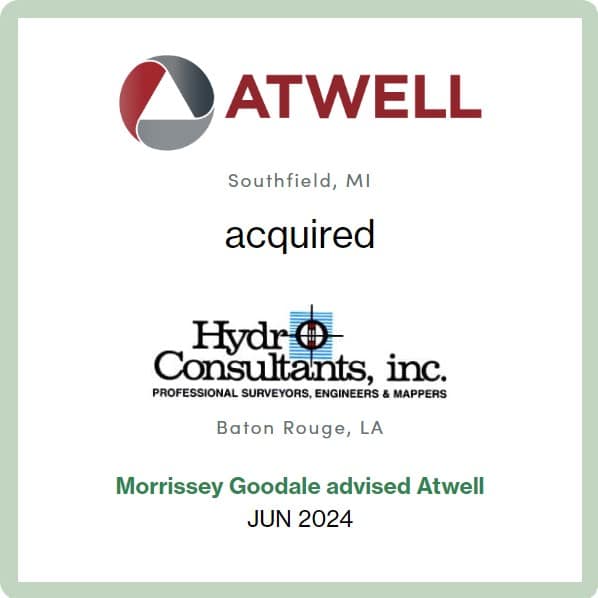Word on the street > Creating “Get To,” Not “Have To,” Jobs; We Stink at Change Management—and We Need to Change That
Word on the Street: Issue 201
Weekly real-time market and industry intelligence from Morrissey Goodale firm leaders.

Creating “Get To,” Not “Have To,” Jobs
THIS is your priority. To create “get to” instead of “have to” jobs for your people. As in, when asked about where they work or what they do, your employees say, “I get to go to work at…” or “I get to work on…” and not “I have to go to work at…” or plain old “I work on…”
As a CEO, this goal should be at the center of your strategic plan. And when you boil it all down—whether you’re the leader of a $1 billion firm or a $10 million firm—there are several ways you and your executive team can create “get to” jobs for your people.
1. “I get to work on the best projects”: How do you and your marketing director make this happen? Target the most interesting clients with the most challenging projects. Pursue those project owners that are pushing the envelope in their industries. Get aligned with the institutions that are exploring the frontiers of health care, science, and technology. Figure out how regulations and technologies are going to change markets and industries, and promote your brand as the thought leader in these areas (skate to where the puck is going…). Position your firm to be the first one called by clients with the most challenging and rewarding projects. Then, your people will say, “I get to work on the best projects.”
2. “I get to work with a great team”: How do you and your chief people officer (or HR director or chief talent person) make this happen? It’s simple, but not easy. Hire, develop, correct, and fire based on your firm’s values. This is why the “soft” part of strategy development is so important. What’s the “soft” part? It’s defining your mission (or purpose), vision, and values. Engineers hate this part of strategic planning—they want to get to the “here’s how we’re going to do this” phase as quickly as possible. Architects, on the other hand, have a hard time progressing beyond it—they love to debate mission, vision, and values—often while the house is burning down around them. But back to working with the best people. Go hard on your values. Live ’em. Make sure your managers embrace them and that every single employee has the opportunity to learn them, apply them, and see them in action. They’re not the prescription for a cult. They’re not a rigid “system.” Instead, they are the guideposts along each employee’s career journey that make clear what’s expected from them and their teammates. Most sets of values never make it beyond just being on a digital page. For those firms where employees feel they “get to work,” values are almost tangible. Struggling with establishing a set of values? Here are ours (we discuss and challenge them a lot!):
• Honest + ethical
• Hard-working
• Responsive
• Reliable
• Continuously improving
• Sincere
• Energetic
• Subject-matter experts (industry)
• On top of client and project engagements
• Direct and to the point, no affectations
• Focused
• Low overhead, low maintenance
• No drama, zero tolerance for bullsh*t
3. “I get to work for a firm that values me”: How do you and your team achieve this? Beyond doing everything that Mark Goodale wrote about in last week’s “What Does It Take to Get Young Professionals to Break the 40-Hour Barrier?,” you need to create outstanding wealth-creation opportunities for them. Best-in-class base compensation, bonuses, benefits. You provide them with the flexibility that meets individual, team, and enterprise needs (no easy feat). You create multiple forums for collaboration—some in company-owned physical spaces, some off-site, some digital. You provide them with all of the tools they need to be successful. You support their research into innovation and improvements and new ideas. Yeah, it’s a lot. But what you’ll get in return is loyalty, commitment, and employees who say “I get to work” for your firm rather than having to work for your competitor.
4. “I get to work for a great firm”: You don’t have to be visionary to have your employees say this. But you (and your executive team) do need to be genuinely mission-driven, committed to growth and continuous improvement, engaged with stakeholder communities, and be super communicative and honest about what’s important and where the firm is headed. So many times we’ve worked with firms where this “secret sauce” is tangible and contagious, and it’s pretty remarkable to see it in action and part of the culture.
5. Coda: Much of this reads like mom and apple pie. That’s the truth. But it’s hard to pull off. And even harder to do it consistently over time. That’s why firms large and small live with a costly 15% turnover rate.
Questions? Comments? Suggestions? You can reach Mick Morrissey @ 508.380.1868 or [email protected].
We Stink at Change Management—and We Need to Change That
With disruption becoming a business norm, adapting to change has turned into a do-or-die proposition. Yet despite the stakes, inertia rules far too many AE firms. While evolving technology, increasingly demanding clients, and regulatory pressures challenge many industries, the culture in AE firms is often rooted in tradition, prioritizing precision and stability, which can breed resistance to change. Furthermore, many AE firm leadership teams lack dedicated change management expertise, making it harder to navigate the necessary transformations. So, let’s explore what change management is, why AE firms often falter in this area, and how to master change management for lasting success.
What is change management?
At its core, change management is a systematic approach to dealing with the transition or transformation of an organization’s goals, processes, or technologies. It involves applying a structured methodology to ensure that changes are smoothly and successfully implemented and that the lasting benefits of the change are achieved. In the context of AE firms, change management might involve adopting new technologies, shifting to sustainable design practices, or merging with another firm.
Why do AE firms struggle with change management?
AE firms face unique challenges when it comes to change management. Here are a few reasons why they often struggle:
- Cultural resistance: The culture in many AE firms is rooted in tradition and long-established practices. Professionals often value precision, stability, and predictability, which can lead to stiff resistance when new processes or technologies are introduced.
- Complex projects and stakeholders: AE projects typically involve multiple stakeholders, including clients, contractors, regulatory bodies, and internal teams. Managing change across such a diverse group can be incredibly complex.
- High stakes and risk aversion: The high stakes associated with architectural and engineering projects mean that change to just about any process associated with doing or supporting the work of a firm can introduce risks. Architects, engineers, and scientists are often risk-averse, fearing that changes could lead to project delays, cost overruns, or quality issues.
- Lack of change management expertise: Many AE firms lack dedicated change management professionals. AE firm principals seldom have the necessary training to effectively lead change initiatives.
Why is effective change management crucial for AE firms?
Why should you prioritize getting better at change management? Here are a few compelling reasons:
- Staying competitive: The AE landscape is evolving rapidly. Firms that adapt quickly to new technologies, market trends, and client demands will simply outpace those that do not. We are already witnessing the early stages of the industry splitting into the haves and have-nots. Some firms are embracing change with open arms, while others cling to the hope that the good ol’ days will soon return—and the gap that is being created as a result will widen rapidly over the next three years.
- Enhancing efficiency and quality: Effective change management leads to more efficient processes, better project outcomes, and higher-quality work. For instance, adopting BIM has helped many industry firms streamline their workflows and improve collaboration.
- Meeting regulatory requirements: The regulatory environment is becoming increasingly stringent. Firms that adeptly manage changes in codes and standards avoid costly penalties and delays.
- Boosting employee morale and engagement: Successfully managing change can lead to a more engaged and motivated workforce. When employees see that their firm’s leadership is proactive and capable of handling change, they are more likely to feel valued, secure, and involved in the solution.
Best practices for implementing change
To navigate the complexities of change management, give these best practices a go:
1. Develop a clear vision and strategy
- Define the change: Clearly articulate what change is needed and why. Whether it’s adopting new technology or shifting to sustainable practices, everyone must understand the goals. Also, be sure to frame what is not going to change.
- Align with business objectives: Ensure that the change aligns with the firm’s long-term strategic objectives. This alignment will help secure buy-in from leadership and stakeholders.
2. Secure leadership buy-in
- Engage leaders early: Involve senior leaders from the outset. Their support is critical for driving the change and overcoming resistance.
- Communicate benefits: Clearly communicate the benefits of the change to leadership, focusing on how it will improve efficiency, quality, and competitiveness.
3. Assess organizational readiness
- Conduct a readiness assessment: Evaluate the current state of the organization to identify potential barriers and enablers of change and address the gaps.
- Identify change agents: Select individuals within the organization who can champion the change and help drive it forward.
4. Develop a comprehensive change plan
- Create a roadmap: Develop a detailed plan that outlines the steps required to achieve the change, including timelines, resources, and key milestones.
- Allocate resources: Ensure that sufficient resources—both human and financial—are allocated to support the change initiative.
5. Communicate effectively
- Develop a communication plan: Create a plan to communicate the change to all stakeholders. Use multiple channels to ensure the message reaches everyone. Again, be sure to communicate what is not going to change as well.
- Be transparent: Maintain open and honest communication throughout the process. Address concerns and provide regular updates on progress.
6. Provide training and support
- Offer training programs: Provide comprehensive training to ensure that employees have the skills and knowledge needed to adapt to the change.
- Offer ongoing support: Establish support mechanisms, such as help desks or mentoring programs, to assist employees as they navigate the change.
7. Implement the change in phases
- Start small: Begin with pilot projects or phased rollouts to test the change in a controlled environment. This approach allows for adjustments before replication and full-scale implementation.
- Monitor and adjust: Accept that you might not get it right the first time (or even the second). Continuously monitor the implementation process and be prepared to make adjustments based on feedback and observed outcomes.
8. Measure and reinforce the change
- Track progress: Use key performance indicators (KPIs) to measure the success of the change initiative. Metrics might be related to efficiency, cost savings, or employee engagement, for example.
- Celebrate successes: Get practiced at recognizing and celebrating milestones and successes to reinforce the positive impact of the change.
9. Sustain the change
- Embed the change: Ensure that the change becomes part of the organizational culture. This internalization might involve updating policies and procedures and assigning/reassigning individual responsibilities.
- Continuous improvement: Foster a culture of continuous improvement where change is seen as an ongoing process rather than a one-time event.
Today, mastering change management isn’t a nice-to have—it’s a strategic imperative. Embrace these best practices and change the way you change.
To contact Mark Goodale, call 508.254.3914 or email [email protected].
Market Snapshot: Infrastructure Investments
Last month, the American Society of Civil Engineers (ASCE) published an updated assessment of the country’s infrastructure. The last ASCE report on infrastructure investments was issued in 2021, months prior to the passing of the Infrastructure Investment and Jobs Act (IIJA) and the Inflation Reduction Act (IRA), which added over $580 billion in funding towards surface transportation, energy, water, airports, and ports and inland waterways. These bills have narrowed the investment gap but are set to expire in 2026. The newly issued report looks at different scenarios over the next 10 and 20 years that quantify total funding needs and anticipated investments. The estimated expenditures between 2024 and 2026 total $344 billion.
Beyond 2026, if federal infrastructure authorizations revert to pre-pandemic levels, anticipated investments would drop by about 17% overall. Below is the breakdown of the potential decreases by infrastructure category:
The report also estimates declines in output by industry if funding levels go back to where they were in 2019. The biggest losers in that scenario would be manufacturing, finance/insurance/real estate, professional services, and logistics. In relative terms, the most negatively impacted sectors would be administrative and support services, waste management and remediation, health care, social assistance, entertainment, and education.
To learn more about market intelligence data and research services offered by Morrissey Goodale, schedule an intro call with Rafael Barbosa.
Weekly M&A Round Up

Congratulations to Atwell (Southfield, MI) (ENR #71): The industry leader acquired Hydro Consultants (Baton Rouge, LA) (ENR #50), a professional surveying, engineering, and mapping services firm. This acquisition expands Atwell’s presence in Louisiana and the Gulf Coast region. We’re thankful that the Atwell team trusted us to advise them on this transaction.
More deals in the South: Last week we reported two deals in Texas in addition to our featured deal in Louisiana. You can check all of last week’s M&A news here. The Texas and the South M&A and Business Symposium is the biggest networking and deal-making event for industry executives and investors. Sign up here to be notified as soon as registration opens!
October 16-18, 2024 Houston, TX
Texas and the South M&A and Business Symposium
Over two-plus information-packed days, come together to discuss strategy, innovation, and M&A trends while networking with AE industry executives.
Learn More
AI & Innovation
Tap Into the Power of AI for your Firm
We’re partnering with the AI experts at Thrivence to bring AI Education and Business Solutions to the AE and environmental consulting Industry. Introducing a powerful 90-minute, on-demand AI Masterclass designed and delivered by CEOs for CEOs.

Searching for an external Board member?
Our Board of Directors candidate database has over one hundred current and former CEOs, executives, business strategists, and experts from both inside and outside the AE and Environmental Consulting industry who are interested in serving on Boards. Contact Tim Pettepit via email or call him directly at (617) 982-3829 for pricing and access to the database.
Are you interested in serving on an AE firm Board of Directors?
We have numerous clients that are seeking qualified industry executives to serve on their boards. If you’re interested, please upload your resume here.
Subscribe to our Newsletters
Stay up-to-date in real-time.











